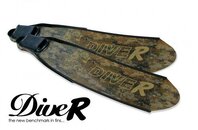Sorry for being unclear.
Large fins will give you slower kick cycle, wrong foot position to keep the blades from hitting each other, and more foot cramps because it'll take more effort to keep the blade from twisting/sliding sideways. Small fins won't mess up your technique, that includes short fast rather than wide slow kicks. Small fins won't build up your leg muscles as fast as larger fins would.
Same goes for hand paddles. There are different shapes and sizes, including just webbed gloves.
When you work legs and arms separately, using fins and paddles resp., you try to not overdevelop one or the other. So if you do fins & kickboard drills in your workout, you'd also do paddles and pull buoy drills. If you're a triathlete you might want to do more of the latter because your legs also get the biking and running workouts that don't involve the arms so much. If you compete in crawls or bat you might want to work the legs more as most propulsion (and effort) in those styles comes from the arms and you legs tend to get underdeveloped. Relatively speaking.
Or at least that's what they told me way back when I swam.
\
Of course, this is good advice for a swimmer that does not care much about diving....but bad advice for a DIVER that was considering swimming for diving fitness.
Training with big freedive fins like DiveR's does mean a slow kick cycle, and a slow heart rate while actual speeds are many times that of a swimmer with tiny fins or no fins. Actual training with these fins means neuromuscular coordination occurs ( for most athletic people) and the fins don't hit each other, and the leg, hip and core muscles all become fit for this activity.
A swimmer in a swim contest, actually wants a high heart rate and breathing rate....and when swimming laps, they want a high use of aerobic system. with little muscle exertion relative to it....
In diving, you want the leg muscles to do the work, rather than heart and lungs...so heart rate may stay at 60 or 70 bpm, with a 2mph pace....while the swimmer would need high heart rate to power the exertion, rather than the large muscles.
On a race bike....this is riding in a big gear--like a 52 x 12 ( what you could go fastest in with unlimited power..think of 5th gear in a sports car....instead of riding the bike in a 42 x 25 ( which is a tiny little gear used to climb a very steep hill....legs spin with little exertion, and heart and lungs provide more aerobic power compared to muscle output). Split fins or barefoot is more like the little gear--the 42-25 or 42x 32..... Big gear on a bike, refers to the original Penny Farthing bikes...the ones with a huge front wheel sometimes 5 feet high or more...with a tiny rear wheel...pedals were on the big wheel....Big wheel meant you could go faster, if you were strong enough--this was a big gear....for lots of hills, the rider of that day would want a bike with a smaller front wheel--a smaller gear

I will ride a 25 mile ( 40k) time trial in a 52 x 13 and average over 25 mph with a heart rate around 183...If I go to a smaller gear like a 52 x 15, it is easier on my leg muscles, but my heart rate will go up to the high 190's or above, which would be above my anaerobic threshold today..and not sustainable for more than a few miles.
With fins, you want the biggest gear you can handle without cramping up in the durations you dive in. Since I rarely dive more than 2 hours, I use a freedive fin that is made to be stiffer than the ones used for 8 hour long freedive competitons--that are quite soft and would spaghetti badly for me on normal dives... If your fins bend all the way, easily, you are wasting power.





